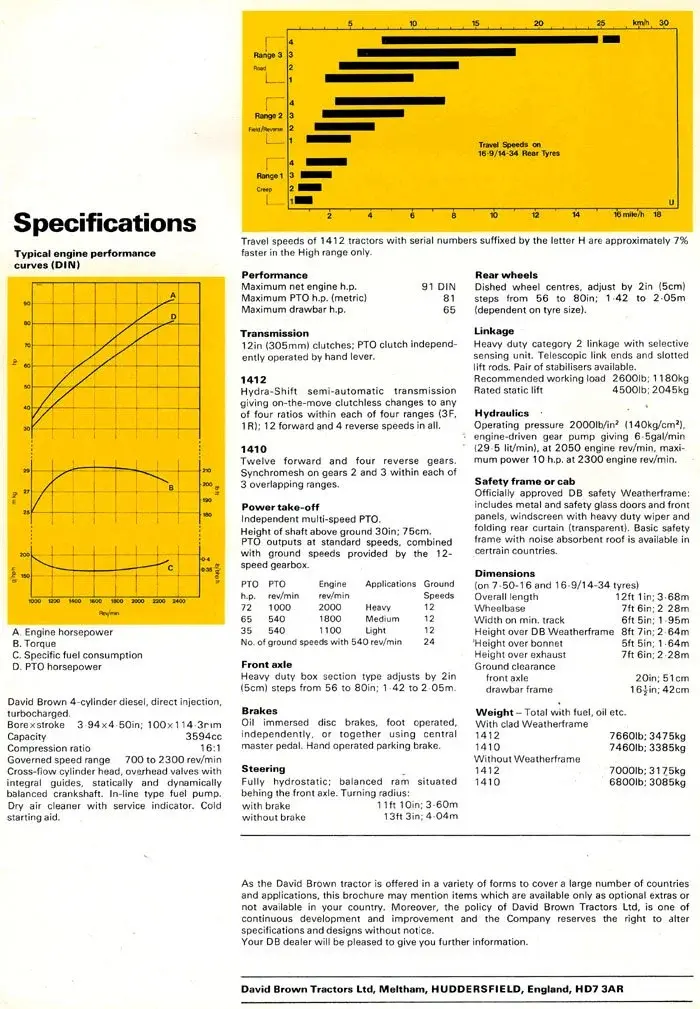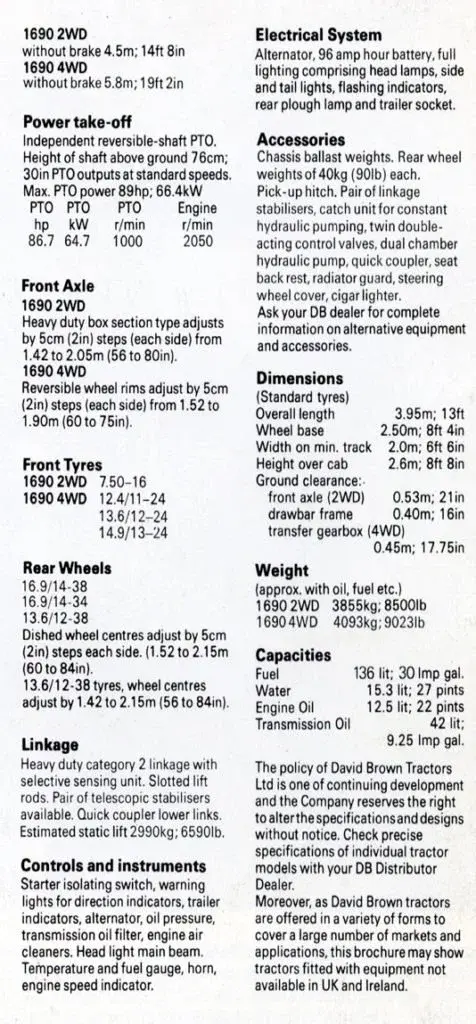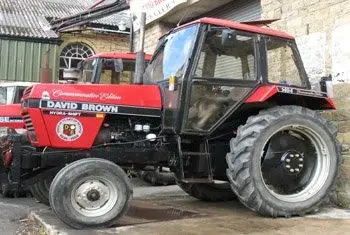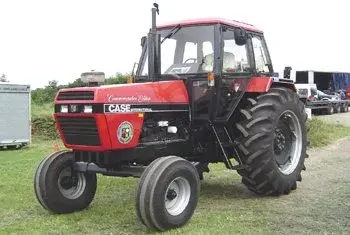Tractor Range
The Tractor Range page lists every David Brown model, with dropdowns showing details such as specifications, years, and features. This section is a work in progress, and we are always looking for more information to add.
Ferguson-Brown Type A (1936–1939)
The Ferguson-Brown Type A was the first production tractor to feature a hydraulic lift with converging three-point linkage, a groundbreaking innovation that set the standard for future tractor design. It was powered by a 4-cylinder, water-cooled petrol or petrol/TVO (gasoline/kerosene) engine.
The first 500 units used a Coventry Climax Type E engine, while the remaining machines (of around 1,350 built) were fitted with a David Brown 2,010cc engine, producing 20 bhp at 1,400 rpm. The tractor had three forward gears, one reverse, and independent wheel brakes, offering excellent control for its time.


VAK1 (1939-1945)
The VAK1 was the first tractor fully designed and built by David Brown. It was powered by a 4-cylinder, water-cooled petrol or petrol/TVO (gasoline/kerosene) engine, producing 35 bhp at 2,000 rpm.
The transmission featured four forward gears and one reverse, and the tractor came equipped with independent hand brakes, a power lift, and a 1 3/8 inch (35mm) PTO shaft.
A David Brown-patented dish wheel centre allowed for adjustable track width, while implement depth was managed via a patented depth (gauge) wheel system. The distinctive streamlined bonnet and windscreen gave the VAK1 a clean, modern appearance for its time.
Specification











VAK1A (1945-1947)
Developed from the successful VAK1, the VAK1A introduced several key improvements. These included an enhanced engine lubrication system and a more precise governor for better performance.
A patented automatic load-controlled hot spot was added for quicker warm-up when running on TVO (kerosene). The model also featured the now-standard turnbuckle top link, another David Brown innovation.
The implement hydraulic lift system was uniquely designed by David Brown to avoid infringement on Harry Ferguson’s three-point linkage patents.



.jpg)
Cropmaster
The long production run of Cropmaster tractors saw many new features pioneered by the company and did much to enhance the reputation for reliability and quality enjoyed by the David Brown tractor.
With the introduction of the Cropmaster, the company introduced the popular policy of including in the standard specification many items normally regarded as extras at this time, such items as hydraulic lift, swinging drawbar and electric lighting.
David Brown introduced the 2-speed PTO, 6-speed gearbox, coil ignition, and the high-speed direct injection diesel engine during this period. The diesel engine was introduced in 1949 and developed 34 bhp at 1800 rev/min.

50D (1953-1958)
The 50D was built around a 6-cylinder, 50 bhp diesel engine, originally developed for a track-laying tractor. A robust and heavy-duty machine, it was particularly well suited to towing operations and came equipped with a four-speed PTO unit.
Unique among David Brown tractors, the 50D featured a side-mounted belt pulley rather than the more common rear-mounted version. It was also the first David Brown model offered exclusively with a diesel engine, marking a significant step in the company's development.


30C AND 30D (1953 – 1957)
The 30C (petrol and TVO) and 30D (diesel) models featured overhead valve engines with either coil ignition or direct injection. Engine output was as follows:
-
Diesel: 34 bhp at 1,800 rpm
-
Petrol: 41 bhp at 2,300 rpm
-
TVO (kerosene): 37.6 bhp at 2,300 rpm
In 1954, the 30C and 30D were introduced with the innovative TCU (Traction Control Unit) — the world’s first controlled weight transfer system for tractors. This became a globally recognised feature and remains one of the most efficient and straightforward systems ever developed.
By 1955, a special trailer hitch was introduced to take full advantage of the TCU when hauling heavy trailers.


Specification
Transmission
-
Borg & Beck single dry plate clutch
-
David Brown gearbox
-
6 forward gears, 2 reverse
Electrical System
-
12V generator and starter by C.A.V.
-
Electric lighting, front and rear
Power Take-Off (Two-Speed)
-
PTO speeds at 1,600 engine rpm:
-
Gear 1: 545 rpm
-
Gear 2: 885 rpm
-
Hydraulic Lift
-
Pump capacity: 36 litres/min
-
Maximum pressure: 80 kg/cm²
-
Max lift capacity at lift arms: 590 kg
Tyres
-
25 Series: Front 6.00 x 19, Rear 11 x 28
-
30 Series: Front 6.00 x 19, Rear 13 x 28 or 11.25 x 28
-

25C AND 25D (1953 - 1957)
The diesel version of the 25 Series produced 31.3 bhp at 1,800 rpm, while the petrol model delivered 37.1 bhp at 2,000 rpm. These were the first small tractors to benefit from the TCU (Traction Control Unit), an innovative system for controlled weight transfer.
Additional features included a 2-speed PTO and belt pulley unit, along with a six-speed gearbox for increased versatility in the field.
Specification
Transmission
-
Borg & Beck single dry plate clutch
-
David Brown gearbox
-
6 forward gears, 2 reverse
Electrical System
-
12V generator and starter by C.A.V.
-
Electric lighting, front and rear
Power Take-Off (Two-Speed)
-
PTO speeds at 1,600 engine rpm:
-
Gear 1: 545 rpm
-
Gear 2: 885 rpm
-
Hydraulic Lift
-
Pump capacity: 36 litres/min
-
Max pressure: 80 kg/cm²
-
Max lift capacity at lift arms: 590 kg
Tyres
-
25 Series: Front 6.00 x 19, Rear 11 x 28
-
30 Series: Front 6.00 x 19, Rear 13 x 28 or 11.25 x 28




-
2D (1956 - 1961)
Ideally suited to precision market gardening, the 2D was also widely used as a specialist row-crop tractor on larger farms. It featured a lightweight, rear-mounted, air-cooled 2-cylinder diesel engine and was specifically designed for use with mid-mounted implements.
A rear lift and PTO were available as optional extras. Both the front and rear lift systems were air-operated, with the two front lift cylinders controllable independently for added versatility.

900 (1956-1958)
The David Brown 900 was offered with a choice of four engine options:
-
Diesel – 40 bhp
-
TVO (kerosene) – 37 bhp
-
Petrol – 40 bhp
-
High-compression petrol – 45 bhp
The diesel version was notable for introducing the now standard distributor-type fuel injection pump. It also featured dual-category linkage, incorporating the David Brown patented swivelling ball-type top link, along with a detachable bonnet for easier maintenance.
In 1957, the 900 Livedrive was launched, the first David Brown tractor to be equipped with a dual clutch, providing live hydraulics and live PTO, marking a major step forward in operational efficiency.

-
950 (T & U) SERIES
The 950 (T & U) Series retained the overall design of the earlier 900 model but offered increased power:
-
Diesel: 42.5 bhp
-
Petrol: 42 bhp
It featured a greatly improved recirculating ball-type steering system for enhanced handling and control.
The universal drawbar was redesigned to meet British Standard 1495:1958 and SAE Standard J718, ensuring better compatibility with a wide range of implements and attachments.

-

950 IMPLEMATIC
(1959-1963)The introduction of the 950 Implematic gave farmers, for the first time, the ability to use depth (gauge) wheel or draught control with equal ease. It also offered automatic weight transfer via the Implematic draught control, or controlled weight transfer through the TCU system.
In 1961, the earlier V and W series was replaced by the 950 Implematic A and B series, which featured improved front axle clearance and a multi-speed PTO, providing both 540 and 1,000 rpm standard output speeds.
Specification





850 IMPLEMATIC (1960-1965)
The 850 Implematic A and B series were equipped with a 4-cylinder diesel engine producing 35 bhp at 2,000 rpm, with petrol versions also available. Thanks to the Implematic hydraulic system, these compact tractors delivered excellent performance with mounted implements.
The later C and D series were diesel-only models and introduced a multi-speed PTO and improved front axle clearance. From April 1963, height control was added to the hydraulic system, enhancing implement handling and precision.
Specification





880 IMPLEMATIC (1961 - 1965)
With a higher speed range than the 950 Implematic, the C and D series 880 proved ideal for the "one-tractor" farm. These models used the same 42.5 bhp 4-cylinder diesel engine, with diesel being the only option on the 880.
In September 1964, both the 950 and 880 Implematic models were replaced by the E and F series 880 Implematic, now fitted with a new 3-cylinder engine.
Two final drive options were available:
-
11/49 (high-speed)
-
9/50 (low-speed)
These provided similar speed ranges to the earlier models, but the higher torque of the new engine offered significantly improved lugging power and overall performance.
Specification




-
990 IMPLEMATIC (1961 - 1965)
The 990 Implematic marked a significant advancement for David Brown, being the first model to feature a cross-flow cylinder head paired with a two-stage front-mounted air cleaner. It was powered by a 52 bhp direct injection diesel engine.
In 1963, several updates were introduced:
-
Height control was added to the Implematic hydraulic system
-
Wheelbase was extended for improved stability
-
A front-mounted battery was fitted
-
An optional 12-speed transmission became available, enhancing versatility across a wider range of tasks

-

770 SELECTAMATIC (1965 - 1970)
The 770 Selectamatic, powered by a 3-cylinder, 35 bhp diesel engine, was the first David Brown tractor to feature the highly effective and simple Selectamatic hydraulic system. Its success led to the system being adopted across the entire David Brown range from October 1965.
Initially launched in traditional red, the 770 also came with a patented 2-lever 12-speed gearbox as standard. Following the introduction of the Selectamatic system, the model was re-styled, repainted in orchid white and chocolate, and upgraded to 36 bhp.
Specification










880 SELECTAMATIC (1965 - 1971)
Equipped with the Selectamatic hydraulic system and finished in the now iconic orchid white livery, the 880 was uprated to 46 bhp. It came as standard with a multi-speed PTO and differential lock. A 12-forward, 4-reverse speed gearbox was available as an option.
These tractors were designed to allow on-farm conversion to and from high-clearance specifications. In 1970, full-flow filtration of the hydraulic oil system was introduced, further improving reliability and performance.

990 SELECTAMATIC (1965 - 1971)
The 990 was fitted with the Selectamatic hydraulic system and featured the distinctive orchid white and updated livery. Rated at 55 bhp, it came as standard with a multi-speed PTO and differential lock. A 12-forward, 4-reverse gearbox was available as an option.
These tractors were designed for on-farm conversion to and from high-clearance use. In 1970, a 4-wheel drive version of the 990 was introduced, and full-flow hydraulic oil filtration was added to improve system efficiency and longevity.

780 SELECTAMATIC (1965 - 1971)
The David Brown 780 was produced at Meltham between 1965 and 1971. It was powered by a 46 hp (34 kW) David Brown engine.
Specification




1200 SELECTAMATIC (1967 - 1971)
This 67 bhp tractor, uprated to 72 bhp in 1968, was the first David Brown model to feature a separate hand clutch for controlling the PTO drive. The hydraulic pump was mounted at the front of the engine, and the three-point linkage was category 2 only. A luxury suspension seat was fitted as standard. A 4-wheel drive version of the 1200 was introduced in 1970.





1210 MANUAL GEAR BOX (1971 - 1980)
Coming soon...

1212 HYDRA-SHIFT (1971 - 1980)
Described as "The Quiet Revolution in Tractor Transmissions", the highly successful semi-automatic Hydra-Shift transmission was introduced to great acclaim and later received a Queen’s Award for Technological Achievement.
Powered by a 72 bhp engine, the 1212 was the first tractor to feature the Hydra-Shift system and also the first non-specialist model to be fitted as standard with hydrostatic power steering, which had previously been offered as an optional extra on other David Brown tractors from 1969.

885 SYNCHROMESH (1971 - 1980)
In 1971, the synchromesh 12-forward, 4-reverse gearbox became standard equipment across all David Brown tractors, with the exception of the 1212. The 885 model replaced both the 780 and 880, combining the best features of each, and was also offered in a Narrow version.
When DIN engine horsepower ratings were adopted in 1972, the 885 was rated at 48 DIN hp. That same year saw the introduction of the David Brown-designed and built Weatherframe safety cab. By 1973, an alternator was fitted as standard.



990, 996 & 996 SELECTAMATIC (1965 - 1971)
In 1971, the synchromesh 12-forward, 4-reverse gearbox became standard on all David Brown tractors, except for the 1212. The ever-reliable 990 continued in production, now equipped with the new synchromesh gearbox. To bridge the gap between the 990 and the earlier 1200 series, the 995 and 996 models were introduced, both delivering 62 engine horsepower. The 996 featured a hand-operated PTO clutch, although unlike the 1200 series, its hydraulic pump remained mounted behind the gearbox. The 1210 synchromesh model succeeded the 1200.
With the introduction of DIN horsepower ratings in 1972, the 990 was rated at 58 DIN hp, while the 995 and 996 were rated at 64 DIN hp. The 1210 and 1212 retained their ratings at 72 DIN hp. Also in 1971, David Brown introduced its own safety cab – the Weatherframe – designed and manufactured in-house. By 1973, alternators became standard equipment across the range.

1410 (1974 - 1980)
David Brown’s first production models with turbocharged engines were rated at 91 hp. These tractors also introduced several new features, including a dry-type engine air cleaner, oil-immersed disc brakes, telescopic lower-link ends, and a balanced hydrostatic steering ram positioned laterally behind the front axle. The 1410 came fitted with a 12-speed synchromesh gearbox as standard.

1412 (1974 - 1980)
David Brown’s first production models with turbocharged engines were rated at 91 hp. These tractors introduced several new features, including a dry-type engine air cleaner, oil-immersed disc brakes, telescopic lower link ends, and a balanced hydrostatic steering ram mounted laterally behind the front axle. The 1412 came fitted with the 12-speed semi-automatic Hydra-Shift transmission.
Specification







1190 (1980-1984)
Launched alongside the more powerful 1290, the David Brown 1190 was equipped with a 48 DIN-rated engine. Standard features included the comfortable DB cab, a 12-speed synchromesh gearbox, hydrostatic steering, single-lever hydraulic control, multi-speed PTO, a hydraulically operated clutch, and self-balancing brakes.
Specification




1290 (1980-1984)
Launched alongside the similar but more powerful 1390, the 1290 was equipped with a 58 DIN-rated engine and offered in both two- and four-wheel drive versions. Standard features included the well-appointed David Brown cab, 12-speed synchromesh gearbox, hydrostatic steering, single-lever hydraulic controls, multi-speed PTO, a hydraulically operated clutch, and self-balancing brakes.

1390 (1980-1984)
The David Brown 1390 featured a more powerful engine than the 1290, delivering 72 DIN horsepower. Available in both 2-wheel and 4-wheel drive versions, it was fitted with a DB cab as standard. Key features included a 12-speed synchromesh gearbox, hydrostatic steering, single-lever hydraulics, multi-speed PTO, hydraulically assisted clutch, and self-balancing brakes.

1490 (1980-1984)
Coming soon...

1690 (1980-1984)
The launch of the 1690 marked David Brown’s return to six-cylinder agricultural tractors—the first since the 50D. With its 100 hp engine, it positioned the company firmly in the market for larger arable farms. The 1690 was offered in both two-wheel and four-wheel drive versions.
Specification





1690 Turbo
Coming Soon...

1194 (1984 - 1988)
These tractors were available in two distinct colour schemes: the earlier "Magpie" livery featuring white tinwork, a black chassis, and red wheels, or the later version with red tinwork, a black chassis, and black or silver wheels.

1294 (1984 - 1988)
These tractors were available in either the "Magpie" colour scheme with white tinwork, a black chassis, and red wheels, or in the later style featuring red tinwork, a black chassis, and black or silver wheels.

1394 (1984 - 1988)
These tractors came in two colour schemes: the earlier "Magpie" style with white tinwork, black chassis, and red wheels, or the later version with red tinwork, black chassis, and black or silver wheels.

1494 (1984 - 1988)
These tractors came in two colour schemes: the earlier "Magpie" style with white tinwork, black chassis, and red wheels, or the later version with red tinwork, black chassis, and black or silver wheels.

1594 (1984 - 1988)
Introduced in 1984, this model replaced the non-turbo 1690 and delivered just under 100 hp. It was available in both 2- and 4-wheel drive, with the choice of a manual gearbox or the Hydra-Shift transmission. It came fitted with the Sekura cab, widely regarded as one of the best ever fitted to a David Brown tractor. An optional dual hydraulic pump allowed certain services to benefit from increased oil flow, and the PTO could be switched between 540 and 1000 rpm by reversing the shaft.
These tractors were available in two colour schemes: the earlier “Magpie” version with white tinwork, black chassis, and red wheels, or the later red tinwork with black chassis and black/silver wheels. The final models produced were badged as Commemorative Edition tractors, celebrating over 50 years of David Brown engineering.
It's unclear how many genuine “Comms” were built. However, some refurbished tractors have been fitted with new decals to appear newer than they are, so buyers should be cautious. These six-cylinder machines were more than capable of handling heavy mounted implements, easily managing 4-furrow ploughs like the Dowdeswell DP7 and 3-metre combination drills.

1694 (1984 - 1988)
These tractors came in two colour schemes: the earlier "Magpie" style with white tinwork, black chassis, and red wheels, or the later version with red tinwork, black chassis, and black or silver wheels.
Specification



LAST DAVID BROWN TRACTOR PRODUCED
Serial No. 11528785 was a 2WD 1594 that rolled off the production line on 11th March 1988.
It holds the distinction of being the last David Brown tractor built. Originally manufactured to U.S. specifications and shipped to the United States, Case IH later decided it should return to its birthplace. The tractor was shipped back to the UK and donated to the David Brown Tractor Club, where it now takes pride of place in the Club’s museum.



